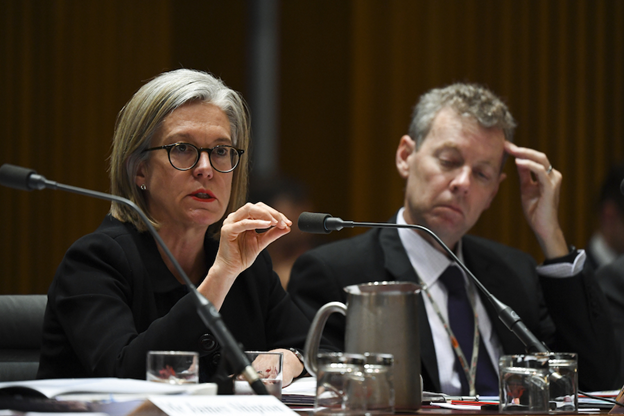ASIC marching to the 'fast and furious' beat of harder regulation. (8 November 2019, Australian Banking Daily)

ASIC deputy chair Karen Chester says while the regulator is seeking to be "an agent provocateur for change", firms still need to be "in the driving seat" of solving corporate governance problems. Image credit: Lukas Coch/AAP.
By Alex Sampson
Fri 8 November 2019
ASIC has spent a bit of time lately myth busting assumptions about its role in a post-Hayne world.
The first myth is that ASIC has become the ethics conduct regulator, deputy chair Karen Chester told a room of bankers and bureaucrats at Melbourne University's Centre for Asian Business and Economics annual conference in Melbourne yesterday.
“It’s important for us to recognise that we are the last line of defence and with that pole position comes an acknowledgement that we cannot singlehandedly deliver ethical behaviour across corporate Australia,” Chester said. “Nor should we try to do so at the end of the day."
“The regulator is an agent provocateur for change, and with that change will come better governance, better professionalism and better accountability. But firms need to be in the driving seat.”
The second myth was that the pendulum had swung toward enforcement, which Chester debunked as “a persistent mis-portrayal" about ASIC's 'why not litigate' approach to enforcement, with “some wrongly and persistently and irritatingly portraying it as 'litigate first'”.
That said, the regulatory raptors insist they are not sleeping on the job, as they’ve been accused of doing in the past.
“All the literature and international experience tells us that to be effective in enforcement-based deterrence, we need to be seen to be active across our entire regulatory purview,” Chester said.
“We need to be seen and heard tap dancing fast and furiously across all of our regulatory tools.”
One area it’s keeping a close eye on is mounting remediation, which over the past two weeks of big bank results has proven to be a larger task than anyone expected.
By June this year banks had collectively paid back A$1.7 billion of ill-gotten gains, with NAB updating the market yesterday that its projected bill alone was creeping up to A$2 billion.
In the area of consumer credit insurance ASIC expects claims will exceed A$100 million paid to 300,000 consumers – and that’s just relating to the sale of add on insurance products at car dealers.
In the first half of the year ASIC finalised refunds of more than A$130 million to 245,000 consumers for fees for no service remediation.
Bad boards
Coming to grips with the poor management of non-financial risks is perhaps the biggest reckoning since Hayne.
And boards have a lot to answer for and prove. They are being watched under the regulator’s two new principal supervisory initiatives, the Corporate Governance Taskforce and the close and continuous monitoring program.
So far ASIC has found that in the pre-Hayne days oversight of non-financial risk was immature compared to financial risk, risk appetite statements were not used well, and reports to boards were often dense and did not clearly highlight key non-financial risks.
“As the royal commission's final report observed, the evidence before the commission showed that too often boards did not get the right information about emerging non-financial risks, and did not do enough to seek better information,” Chester said.
“We have seen the systemic and real harm that can occur to customers, companies and ultimately shareholders themselves when governance and accountability are neglected.
ASIC wants boards to challenge management so they can be “satisfied that problems are not buried, but instead identified promptly and dealt with appropriately and not as a set and forget exercise”.
Professor David Larcker, the director of the Corporate Governance Research Initiative at Stanford University, told delegates during a panel discussion there was a “tremendous opportunity for boards to step up and do a better job”.
“Boards do not, in my opinion, do a very good job — including the boards that I'm on — of evaluating the performance of the board,” Larcker said.
“The thing that's hard to assess is the board dynamics. Who gets to talk? Is there enough room for disagreement? I've been on boards where basically there's such a push for everybody to agree quickly that it just diminishes the real diversity of opinion on boards.
“Obviously diversity and is the kind of issue that is paramount.”
Former Vice Minister of Finance for International Affairs in Japan, Masatsugu Asakawa, discussed Japan’s corporate governance reforms and said under the country’s “Revitalisation Strategy” the number of female executives had increased to more than 2,100, up nearly 2.5 times the number five years ago and reaching 5.2% of all executives of listed companies.
The refresh had also seen most major investors disclose voting results of AGMs by individual company/agenda basis.
ANZ deputy CEO Alexis George referenced the bank’s secretive self-assessment report submitted to APRA, which it had thus far refused to release publicly, saying it reflected on the need to focus more on non-financial risks in the boardroom.
“I think there has been times in the past where remuneration has created and rewarded bad behaviour and we need to acknowledge and address that,” George said.
“I think we're at the beginning of a journey of a lot of change. I don't think we're there yet, by no means.
“I think we don't need to be back in this situation. The royal commission was a pretty confronting experience.”
Source: Australian Banking Daily. Accessible: https://bankingdaily.com.au/